mirror SKODA FABIA 2010 2.G / 5J Owner's Manual
[x] Cancel search | Manufacturer: SKODA, Model Year: 2010, Model line: FABIA, Model: SKODA FABIA 2010 2.G / 5JPages: 244, PDF Size: 29.53 MB
Page 4 of 244
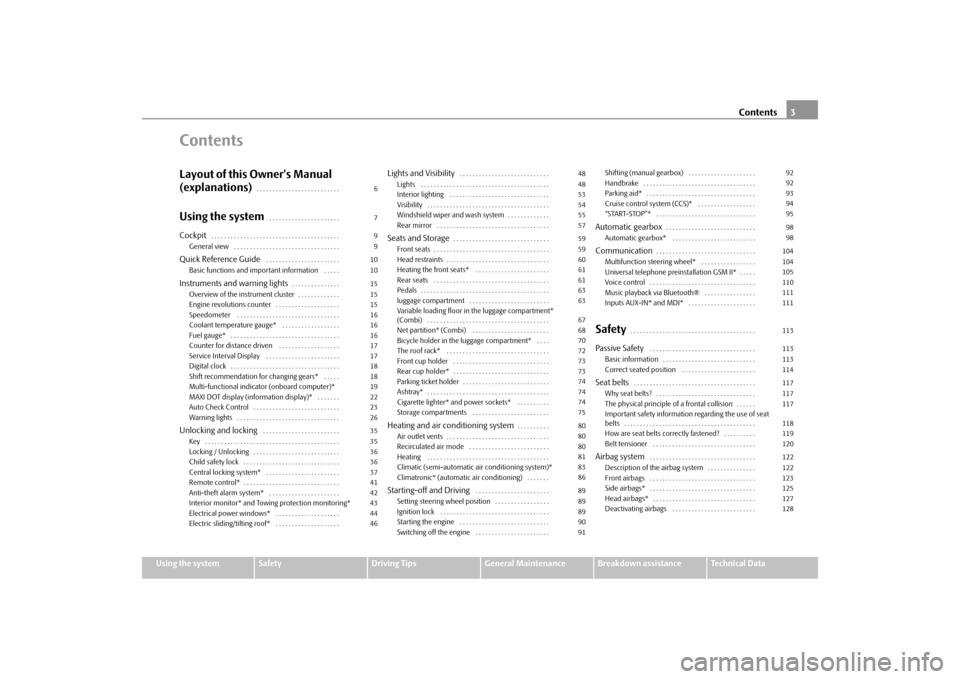
Contents3
Using the system
Safety
Driving Tips
General Maintenance
Breakdown assistance
Technical Data
ContentsLayout of this Owner's Manual
(explanations)
. . . . . . . . . . . . . . . . . . . . . . . . . .
Using the system
. . . . . . . . . . . . . . . . . . . . . .
Cockpit
. . . . . . . . . . . . . . . . . . . . . . . . . . . . . . . . . . . . . . . .
General view . . . . . . . . . . . . . . . . . . . . . . . . . . . . . . . . .
Quick Reference Guide
. . . . . . . . . . . . . . . . . . . . . . .
Basic functions and important information . . . . .
Instruments and warning lights
. . . . . . . . . . . . . . .
Overview of the instrument cluster . . . . . . . . . . . . .
Engine revolutions counter . . . . . . . . . . . . . . . . . . . .
Speedometer . . . . . . . . . . . . . . . . . . . . . . . . . . . . . . . .
Coolant temperature gauge* . . . . . . . . . . . . . . . . . .
Fuel gauge* . . . . . . . . . . . . . . . . . . . . . . . . . . . . . . . . . .
Counter for distance driven . . . . . . . . . . . . . . . . . . .
Service Interval Display . . . . . . . . . . . . . . . . . . . . . . .
Digital clock . . . . . . . . . . . . . . . . . . . . . . . . . . . . . . . . . .
Shift recommendation for changing gears* . . . . .
Multi-functional indicator (onboard computer)*
MAXI DOT display (information display)* . . . . . . .
Auto Check Control . . . . . . . . . . . . . . . . . . . . . . . . . . .
Warning lights . . . . . . . . . . . . . . . . . . . . . . . . . . . . . . . .
Unlocking and locking
. . . . . . . . . . . . . . . . . . . . . . . .
Key . . . . . . . . . . . . . . . . . . . . . . . . . . . . . . . . . . . . . . . . . .
Locking / Unlocking . . . . . . . . . . . . . . . . . . . . . . . . . . .
Child safety lock . . . . . . . . . . . . . . . . . . . . . . . . . . . . . .
Central locking system* . . . . . . . . . . . . . . . . . . . . . . .
Remote control* . . . . . . . . . . . . . . . . . . . . . . . . . . . . . .
Anti-theft alarm system* . . . . . . . . . . . . . . . . . . . . . .
Interior monitor* and Towing protection monitoring*
Electrical power windows* . . . . . . . . . . . . . . . . . . . .
Electric sliding/tilting roof* . . . . . . . . . . . . . . . . . . . .
Lights and Visibility
. . . . . . . . . . . . . . . . . . . . . . . . . . . .
Lights . . . . . . . . . . . . . . . . . . . . . . . . . . . . . . . . . . . . . . . .
Interior lighting . . . . . . . . . . . . . . . . . . . . . . . . . . . . . . .
Visibility . . . . . . . . . . . . . . . . . . . . . . . . . . . . . . . . . . . . . .
Windshield wiper and wash system . . . . . . . . . . . . .
Rear mirror . . . . . . . . . . . . . . . . . . . . . . . . . . . . . . . . . . .
Seats and Storage
. . . . . . . . . . . . . . . . . . . . . . . . . . . . . .
Front seats . . . . . . . . . . . . . . . . . . . . . . . . . . . . . . . . . . . .
Head restraints . . . . . . . . . . . . . . . . . . . . . . . . . . . . . . . .
Heating the front seats* . . . . . . . . . . . . . . . . . . . . . . .
Rear seats . . . . . . . . . . . . . . . . . . . . . . . . . . . . . . . . . . . .
Pedals . . . . . . . . . . . . . . . . . . . . . . . . . . . . . . . . . . . . . . . .
luggage compartment . . . . . . . . . . . . . . . . . . . . . . . . .
Variable loading floor in the luggage compartment*
(Combi) . . . . . . . . . . . . . . . . . . . . . . . . . . . . . . . . . . . . . .
Net partition* (Combi) . . . . . . . . . . . . . . . . . . . . . . . .
Bicycle holder in the luggage compartment* . . . .
The roof rack* . . . . . . . . . . . . . . . . . . . . . . . . . . . . . . . .
Front cup holder . . . . . . . . . . . . . . . . . . . . . . . . . . . . . .
Rear cup holder* . . . . . . . . . . . . . . . . . . . . . . . . . . . . . .
Parking ticket holder . . . . . . . . . . . . . . . . . . . . . . . . . . .
Ashtray* . . . . . . . . . . . . . . . . . . . . . . . . . . . . . . . . . . . . . .
Cigarette lighter* and power sockets* . . . . . . . . . .
Storage compartments . . . . . . . . . . . . . . . . . . . . . . . .
Heating and air conditioning system
. . . . . . . . . .
Air outlet vents . . . . . . . . . . . . . . . . . . . . . . . . . . . . . . . .
Recirculated air mode . . . . . . . . . . . . . . . . . . . . . . . . .
Heating . . . . . . . . . . . . . . . . . . . . . . . . . . . . . . . . . . . . . .
Climatic (semi-automatic air conditioning system)*
Climatronic* (automatic air conditioning) . . . . . . .
Starting-off and Driving
. . . . . . . . . . . . . . . . . . . . . . .
Setting steering wheel position . . . . . . . . . . . . . . . . .
Ignition lock . . . . . . . . . . . . . . . . . . . . . . . . . . . . . . . . . .
Starting the engine . . . . . . . . . . . . . . . . . . . . . . . . . . . .
Switching off the engine . . . . . . . . . . . . . . . . . . . . . . .Shifting (manual gearbox) . . . . . . . . . . . . . . . . . . . . .
Handbrake . . . . . . . . . . . . . . . . . . . . . . . . . . . . . . . . . . .
Parking aid* . . . . . . . . . . . . . . . . . . . . . . . . . . . . . . . . . .
Cruise control system (CCS)* . . . . . . . . . . . . . . . . . .
“START-STOP”* . . . . . . . . . . . . . . . . . . . . . . . . . . . . . . .
Automatic gearbox
. . . . . . . . . . . . . . . . . . . . . . . . . . . .
Automatic gearbox* . . . . . . . . . . . . . . . . . . . . . . . . . .
Communication
. . . . . . . . . . . . . . . . . . . . . . . . . . . . . . .
Multifunction steering wheel* . . . . . . . . . . . . . . . . .
Universal telephone preinstallation GSM II* . . . . .
Voice control . . . . . . . . . . . . . . . . . . . . . . . . . . . . . . . . .
Music playback via Bluetooth® . . . . . . . . . . . . . . . .
Inputs AUX-IN* and MDI* . . . . . . . . . . . . . . . . . . . . .
Safety
. . . . . . . . . . . . . . . . . . . . . . . . . . . . . . . . . . . . . . .
Passive Safety
. . . . . . . . . . . . . . . . . . . . . . . . . . . . . . . . .
Basic information . . . . . . . . . . . . . . . . . . . . . . . . . . . . .
Correct seated position . . . . . . . . . . . . . . . . . . . . . . .
Seat belts
. . . . . . . . . . . . . . . . . . . . . . . . . . . . . . . . . . . . . .
Why seat belts? . . . . . . . . . . . . . . . . . . . . . . . . . . . . . . .
The physical principle of a frontal collision . . . . . .
Important safety information regarding the use of seat
belts . . . . . . . . . . . . . . . . . . . . . . . . . . . . . . . . . . . . . . . . .
How are seat belts correctly fastened? . . . . . . . . . .
Belt tensioner . . . . . . . . . . . . . . . . . . . . . . . . . . . . . . . .
Airbag system
. . . . . . . . . . . . . . . . . . . . . . . . . . . . . . . . .
Description of the airbag system . . . . . . . . . . . . . . .
Front airbags . . . . . . . . . . . . . . . . . . . . . . . . . . . . . . . . .
Side airbags* . . . . . . . . . . . . . . . . . . . . . . . . . . . . . . . . .
Head airbags* . . . . . . . . . . . . . . . . . . . . . . . . . . . . . . . .
Deactivating airbags . . . . . . . . . . . . . . . . . . . . . . . . . .
67991010151515161616171718181922232635353636374142434446
48485354555759596061616363676870727373747474758080808183868989899091
92929394959898104104105110111111113113113114117117117118119120122122123125127128
s3j8.a.book Page 3 Tuesday, April 20, 2010 1:10 PM
Page 10 of 244
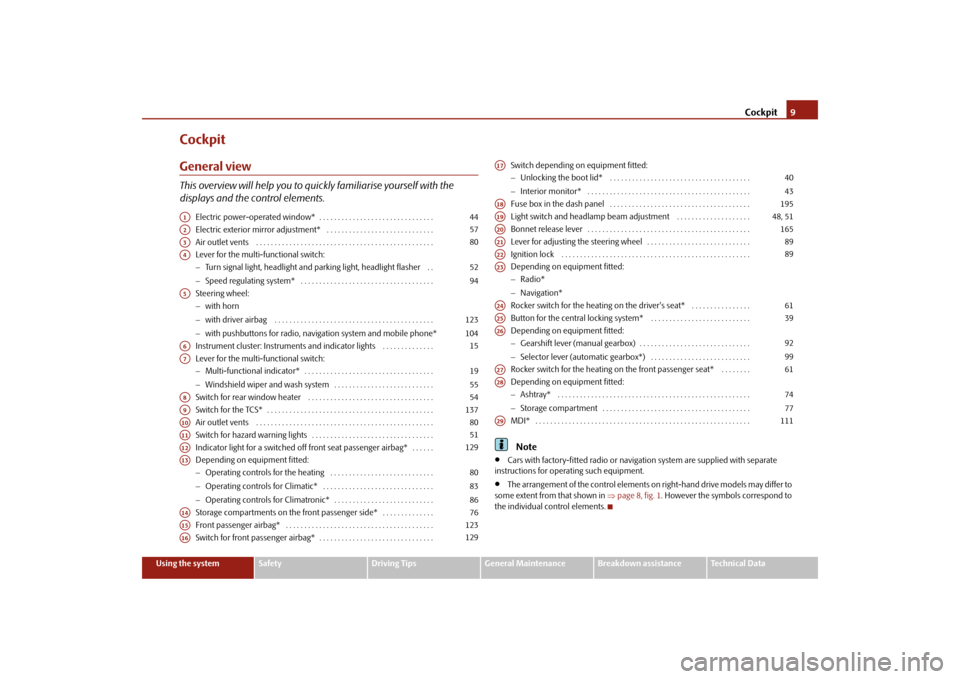
Cockpit
9
Using the system
Safety
Driving Tips
General Maintenance
Breakdown assistance
Technical Data
CockpitGeneral viewThis overview will help you to quic
kly familiarise yourself with the
displays and the control elements.
Electric power-operated window* . . . . . . . . . . . . . . . . . . . . . . . . . . . . . . . Electric exterior mirror adjustment* . . . . . . . . . . . . . . . . . . . . . . . . . . . . . Air outlet vents . . . . . . . . . . . . . . . . . . . . . . . . . . . . . . . . . . . . . . . . . . . . . . . . Lever for the multi-functional switch: Turn signal light, headlight and parking light, headlight flasher . . Speed regulating system* . . . . . . . . . . . . . . . . . . . . . . . . . . . . . . . . . . . . Steering wheel: with horn with driver airbag . . . . . . . . . . . . . . . . . . . . . . . . . . . . . . . . . . . . . . . . . . . with pushbuttons for radio, navi
gation system and mobile phone*
Instrument cluster: Instruments and indicator lights . . . . . . . . . . . . . . Lever for the multi-functional switch: Multi-functional indicator* . . . . . . . . . . . . . . . . . . . . . . . . . . . . . . . . . . . Windshield wiper and wash system . . . . . . . . . . . . . . . . . . . . . . . . . . . Switch for rear window heater . . . . . . . . . . . . . . . . . . . . . . . . . . . . . . . . . . Switch for the TCS* . . . . . . . . . . . . . . . . . . . . . . . . . . . . . . . . . . . . . . . . . . . . . Air outlet vents . . . . . . . . . . . . . . . . . . . . . . . . . . . . . . . . . . . . . . . . . . . . . . . .Switch for hazard warning lights . . . . . . . . . . . . . . . . . . . . . . . . . . . . . . . . . Indicator light for a switched off front seat passenger airbag* . . . . . . Depending on equipment fitted: Operating controls for the heating . . . . . . . . . . . . . . . . . . . . . . . . . . . . Operating controls for Climatic* . . . . . . . . . . . . . . . . . . . . . . . . . . . . . . Operating controls for Climatronic* . . . . . . . . . . . . . . . . . . . . . . . . . . . Storage compartments on the front passenger side* . . . . . . . . . . . . . .Front passenger airbag* . . . . . . . . . . . . . . . . . . . . . . . . . . . . . . . . . . . . . . . . Switch for front passenger airbag* . . . . . . . . . . . . . . . . . . . . . . . . . . . . . . .
Switch depending on equipment fitted: Unlocking the boot lid* . . . . . . . . . . . . . . . . . . . . . . . . . . . . . . . . . . . . . . Interior monitor* . . . . . . . . . . . . . . . . . . . . . . . . . . . . . . . . . . . . . . . . . . . . Fuse box in the dash panel . . . . . . . . . . . . . . . . . . . . . . . . . . . . . . . . . . . . . . Light switch and headlamp beam adjustment . . . . . . . . . . . . . . . . . . . .Bonnet release lever . . . . . . . . . . . . . . . . . . . . . . . . . . . . . . . . . . . . . . . . . . . . Lever for adjusting the steering wheel . . . . . . . . . . . . . . . . . . . . . . . . . . . . Ignition lock . . . . . . . . . . . . . . . . . . . . . . . . . . . . . . . . . . . . . . . . . . . . . . . . . . .Depending on equipment fitted: Radio* Navigation* Rocker switch for the heating on the driver's seat* . . . . . . . . . . . . . . . .Button for the central locking system* . . . . . . . . . . . . . . . . . . . . . . . . . . . Depending on equipment fitted: Gearshift lever (manual gearbox) . . . . . . . . . . . . . . . . . . . . . . . . . . . . . . Selector lever (automatic gearbox*) . . . . . . . . . . . . . . . . . . . . . . . . . . . Rocker switch for the heating on the front passenger seat* . . . . . . . . Depending on equipment fitted: Ashtray* . . . . . . . . . . . . . . . . . . . . . . . . . . . . . . . . . . . . . . . . . . . . . . . . . . . . Storage compartment . . . . . . . . . . . . . . . . . . . . . . . . . . . . . . . . . . . . . . . . MDI* . . . . . . . . . . . . . . . . . . . . . . . . . . . . . . . . . . . . . . . . . . . . . . . . . . . . . . . . . .Note
Cars with factory-fitted radio or naviga
tion system are supplied with separate
instructions for operating such equipment.
The arrangement of the control elements on right-hand drive models may differ to
some extent from that shown in
page 8, fig. 1
. However the symbols correspond to
the individual control elements.
A1
44
A2
57
A3
80
A4
5294
A5
123104
A6
15
A7
1955
A8
54
A9
137
A10
80
A11
51
A12
129
A13
808386
A14
76
A15
123
A16
129
A17
4043
A18
195
A19
48, 51
A20
165
A21
89
A22
89
A23A24
61
A25
39
A26
9299
A27
61
A28
7477
A29
111
s3j8.a.book Page 9 Tuesday, April 20, 2010 1:10 PM
Page 12 of 244
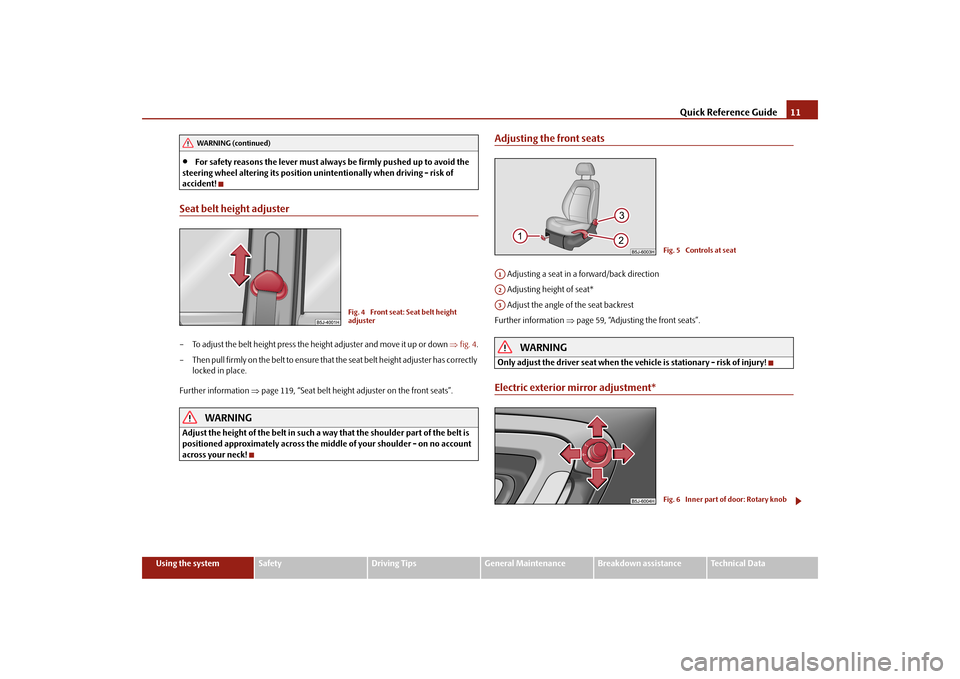
Quick Reference Guide
11
Using the system
Safety
Driving Tips
General Maintenance
Breakdown assistance
Technical Data
For safety reasons the lever must always be firmly pushed up to avoid the
steering wheel alteri
ng its position unintentionally when driving - risk of
accident!Seat belt height adjuster– To adjust the belt height press the height adjuster and move it up or down
fig. 4
.
– Then pull firmly on the belt to ensure that
the seat belt height
adjuster has correctly
locked in place.
Further information
page 119, “Seat belt height ad
juster on the front seats”.
WARNING
Adjust the height of the belt in such a way that the shoulder part of the belt is positioned approximately across the middle of your shoulder - on no account across your neck!
Adjusting the front seats Adjusting a seat in a forward/back direction Adjusting height of seat* Adjust the angle of the seat backrestFurther information
page 59, “Adjusting the front seats”.
WARNING
Only adjust the driver seat when the ve
hicle is stationary - risk of injury!
Electric exterior mirror adjustment*
WARNING (continued)
Fig. 4 Front seat: Seat belt height adjuster
Fig. 5 Controls at seat
A1A2A3
Fig. 6 Inner part of door: Rotary knob
s3j8.a.book Page 11 Tuesday, April 20, 2010 1:10 PM
Page 13 of 244
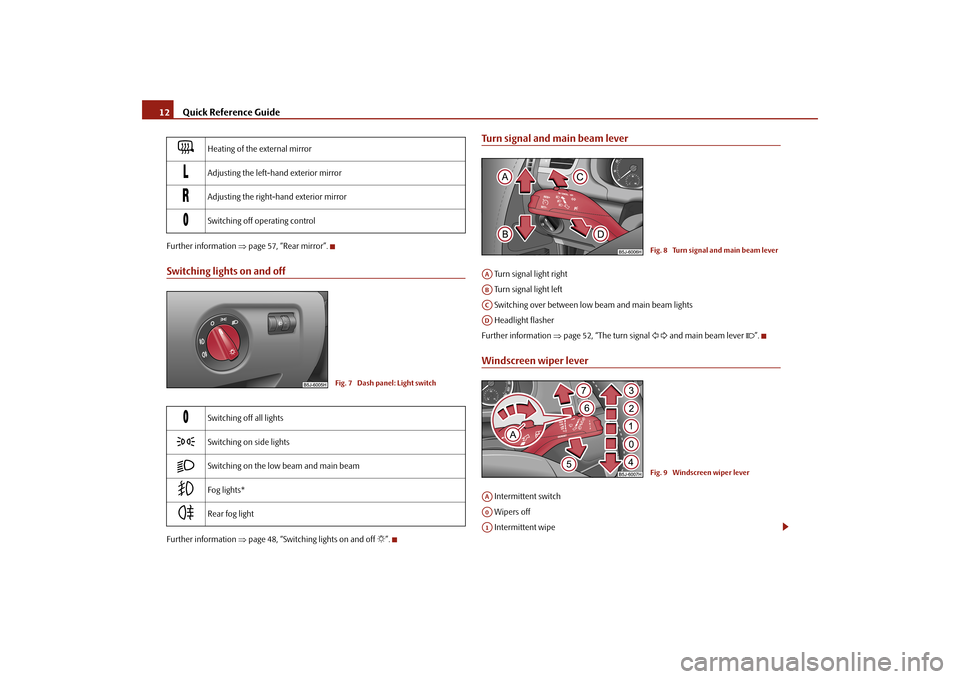
Quick Reference Guide
12Further information
page 57, “Rear mirror”.
Switching lights on and offFurther information
page 48, “Switching
lights on and off
”.
Turn signal and main beam lever Turn signal light right Turn signal light left Switching over between low beam and main beam lights Headlight flasherFurther information
page 52, “The turn signal
and main beam lever
”.
Windscreen wiper lever Intermittent switch Wipers off Intermittent wipe
Heating of the external mirror
Adjusting the left-hand exterior mirror
Adjusting the right-hand exterior mirror
Switching off operating control
Switching off all lights
Switching on side lights
Switching on the low beam and main beam
Fog lights*
Rear fog light
Fig. 7 Dash panel: Light switch
Fig. 8 Turn signal and main beam lever
AAABACAD
Fig. 9 Windscreen wiper lever
AA A0 A1
s3j8.a.book Page 12 Tuesday, April 20, 2010 1:10 PM
Page 55 of 244
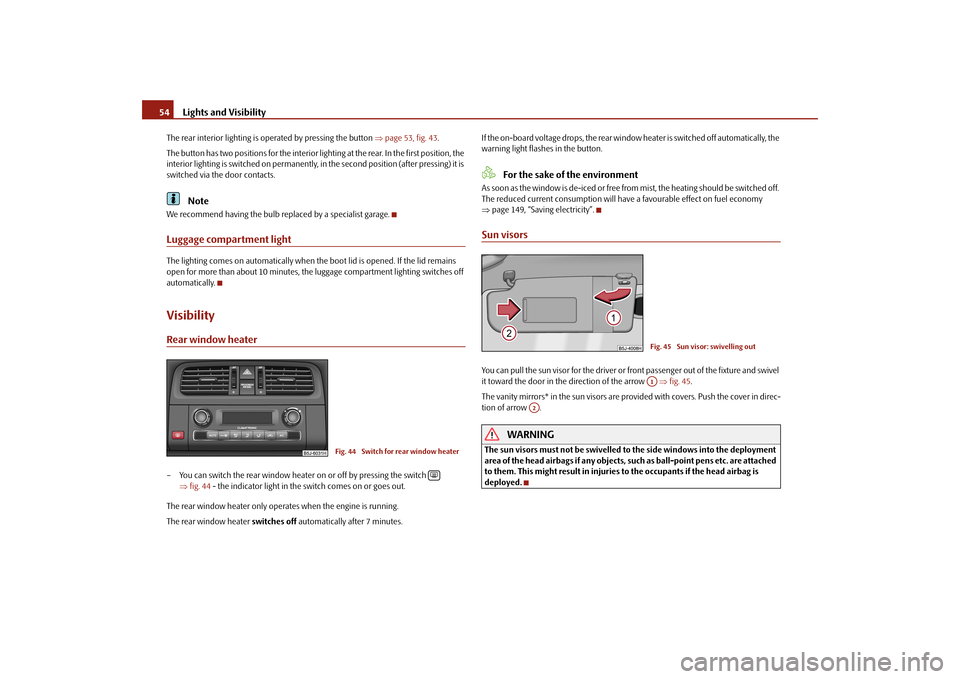
Lights and Visibility
54The rear interior lighting is op
erated by pressi
ng the button
page 53, fig. 43
.
The button has two positions for the interior li
ghting at the rear. In the first position, the
interior lighting is switched on permanently, in the second position (after pressing) it is switched via the door contacts.
Note
We recommend having the bulb replaced by a specialist garage.Luggage compartment lightThe lighting comes on automatically when th
e boot lid is opened. If the lid remains
open for more than about 10
minutes, the luggage compartment lighting switches off
automatically.VisibilityRear window heater– You can switch the rear window heater
on or off by pressing the switch
fig. 44
- the indicator light in the switch comes on or goes out.
The rear window heater only operates when the engine is running. The rear wind
ow heater
switches
off automatically after 7 minutes.
If the on-board voltage drops, the rear window
heater is switched off automatically, the
warning light flashes in the button.
For the sake of the environment
As soon as the window is de-iced or free fr
om mist, the heating should be switched off.
The reduced current consumption will have a favourable effect on fuel economy page 149, “Saving electricity”.Sun visorsYou can pull the sun visor for the driver or front passenger out of the fixture and swivel it toward the door in the direction of the arrow
fig. 45
.
The vanity mirrors* in the sun visors are provided with covers. Push the cover in direc- tion of arrow .
WARNING
The sun visors must not be swivelled to the side windows into the deployment area of the head airbags if any objects, su
ch as ball-point pens
etc. are attached
to them. This might result in injuries to the occupants if the head airbag is deployed.
Fig. 44 Switch for rear window heater
Fig. 4 Sun visor: swivelling outA1
A2
s3j8.a.book Page 54 Tuesday, April 20, 2010 1:10 PM
Page 58 of 244
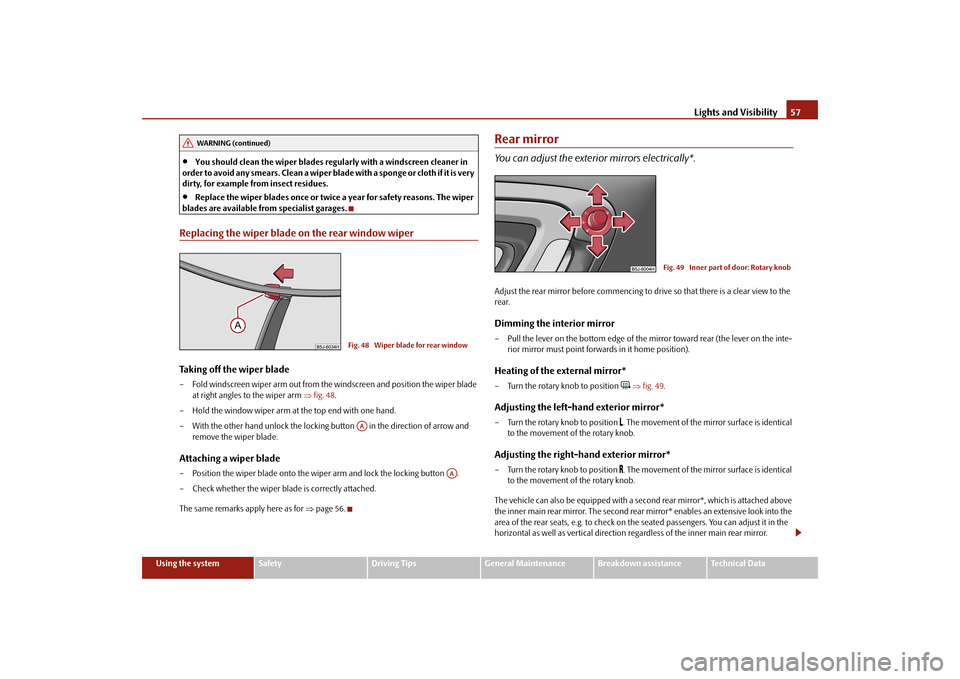
Lights and Visibility
57
Using the system
Safety
Driving Tips
General Maintenance
Breakdown assistance
Technical Data
You should clean the wiper blades regu
larly with a windscreen cleaner in
order to avoid any smears. Clean a wiper blad
e with a sponge or cloth if it is very
dirty, for example from insect residues.
Replace the wiper blades once or twice a year for safety reasons. The wiper
blades are available from specialist garages.Replacing the wiper blade on the rear window wiperTaking off the wiper blade– Fold windscreen wiper arm out from the windscreen and position the wiper blade
at right angles to the wiper arm
fig. 48
.
– Hold the window wiper arm at the top end with one hand.– With the other hand unlock the locking button in the direction of arrow and
remove the wiper blade.
Attaching a wiper blade– Position the wiper blade onto the wiper arm and lock the locking button . – Check whether the wiper bl
ade is correctly attached.
The same remarks apply here as for
page 56.
Rear mirrorYou can adjust the exterior mirrors electrically*.Adjust the rear mirror before commencing to drive so that there is a clear view to the rear.Dimming the interior mirror– Pull the lever on the bottom edge of the mirror toward rear (the lever on the inte-
rior mirror must point forwards in it home position).
Heating of the external mirror*– Turn the rotary knob to position
fig. 49
.
Adjusting the left-hand exterior mirror*– Turn the rotary knob to position
. The movement of the mirror surface is identical
to the movement of the rotary knob.
Adjusting the right-hand exterior mirror*– Turn the rotary knob to position
. The movement of the mirror surface is identical
to the movement of the rotary knob.
The vehicle can also be equipp
ed with a second rear mirror*, which is attached above
the inner main rear mirror. Th
e second rear mirror* enables an extensive look into the
area of the rear seats, e.g. to check on the seated passengers. You can adjust it in the horizontal as well as vertical direction re
gardless of the inner main rear mirror.
WARNING (continued)
Fig. 48 Wiper blade for rear windowAA
AA
Fig. 49 Inner part of door: Rotary knob
s3j8.a.book Page 57 Tuesday, April 20, 2010 1:10 PM
Page 59 of 244
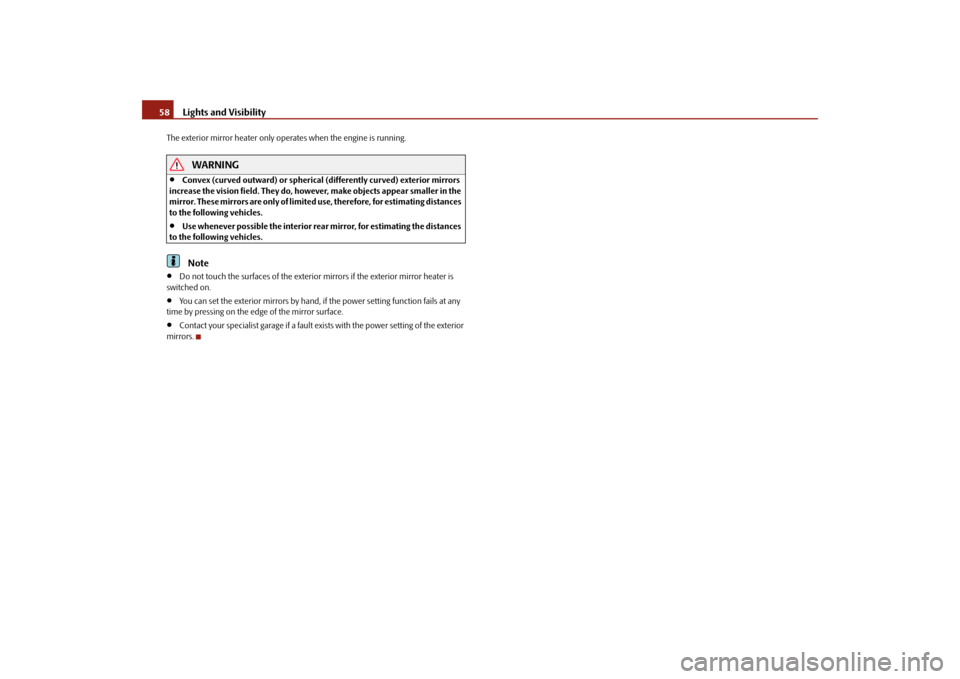
Lights and Visibility
58The exterior mirror heater only op
erates when the engine is running.
WARNING
Convex (curved outward) or spherical (differently curved) exterior mirrors
increase the vision field. They do, howe
ver, make objects appear smaller in the
mirror. These mirrors are only of limited
use, therefore, for estimating distances
to the following vehicles.
Use whenever possible the interior rear
mirror, for estimating the distances
to the following vehicles.
Note
Do not touch the surfaces of the exterior mirrors if the exterior mirror heater is
switched on.
You can set the exterior mirrors by hand, if
the power setting function fails at any
time by pressing on the edge of the mirror surface.
Contact your specialist garage if a fault ex
ists with the power setting of the exterior
mirrors.s3j8.a.book Page 58 Tuesday, April 20, 2010 1:10 PM
Page 115 of 244
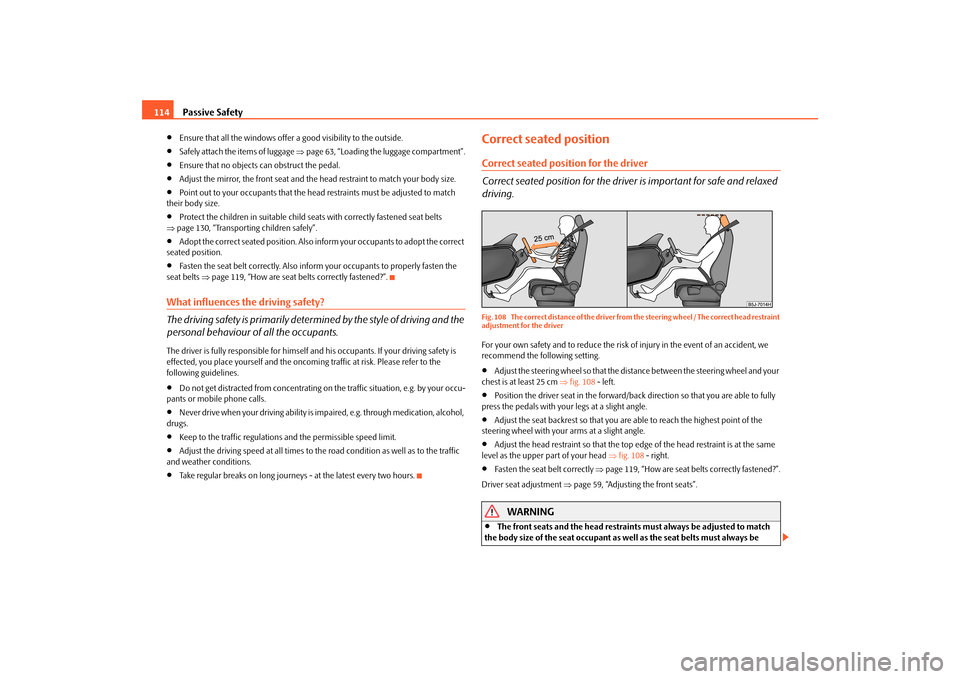
Passive Safety
114
Ensure that all the windows offer
a good visibility to the outside.
Safely attach the items of luggage
page 63, “Loading the luggage compartment”.
Ensure that no objects can obstruct the pedal.
Adjust the mirror, the front seat and the head restraint to match your body size.
Point out to your occupants that the head
restraints must be adjusted to match
their body size.
Protect the children in suitable child seats with correctly fastened seat belts
page 130, “Transporting children safely”.
Adopt the correct seated position. Also in
form your occupants to adopt the correct
seated position.
Fasten the seat belt correctly. Also inform your occupants to properly fasten the
seat belts
page 119, “How are seat be
lts correctly fastened?”.
What influences the driving safety? The driving safety is primarily determined by the style of driving and the personal behaviour of all the occupants.The driver is fully responsible for himself an
d his occupants. If yo
ur driving safety is
effected, you place yourself and the oncomi
ng traffic at risk. Please refer to the
following guidelines.
Do not get distracted from concentrating on the traffic situation, e.g. by your occu-
pants or mobile phone calls.
Never drive when your driving ability is impaired, e.g. through medication, alcohol,
drugs.
Keep to the traffic regulations and the permissible speed limit.
Adjust the driving speed at all times to the road condition as well as to the traffic
and weather conditions.
Take regular breaks on long journe
ys - at the latest every two hours.
Correct seated positionCorrect seated position for the driver Correct seated position for the driver is important for safe and relaxed driving.Fig. 108 The correct distance of the driver from
the steering wheel / The
correct head restraint
adjustment for the driverFor your own safety and to reduce the risk of injury in the event of an accident, we recommend the following setting.
Adjust the steering wheel so that the distance between the steering wheel and your
chest is at least 25 cm
fig. 108
- left.
Position the driver seat in the forward/back direction so that you are able to fully
press the pedals with your legs at a slight angle.
Adjust the seat backrest so that you are able to reach the highest point of the
steering wheel with your arms at a slight angle.
Adjust the head restraint so that the top edge of the head restraint is at the same
level as the upper part of your head
fig. 108
- right.
Fasten the seat belt correctly
page 119, “How are seat belts correctly fastened?”.
Driver seat adjustment
page 59, “Adjusting the front seats”.
WARNING
The front seats and the head restraints must always be adjusted to match
the body size of the seat occupant as well as the seat belts must always be
s3j8.a.book Page 114 Tuesday, April 20, 2010 1:10 PM
Page 153 of 244
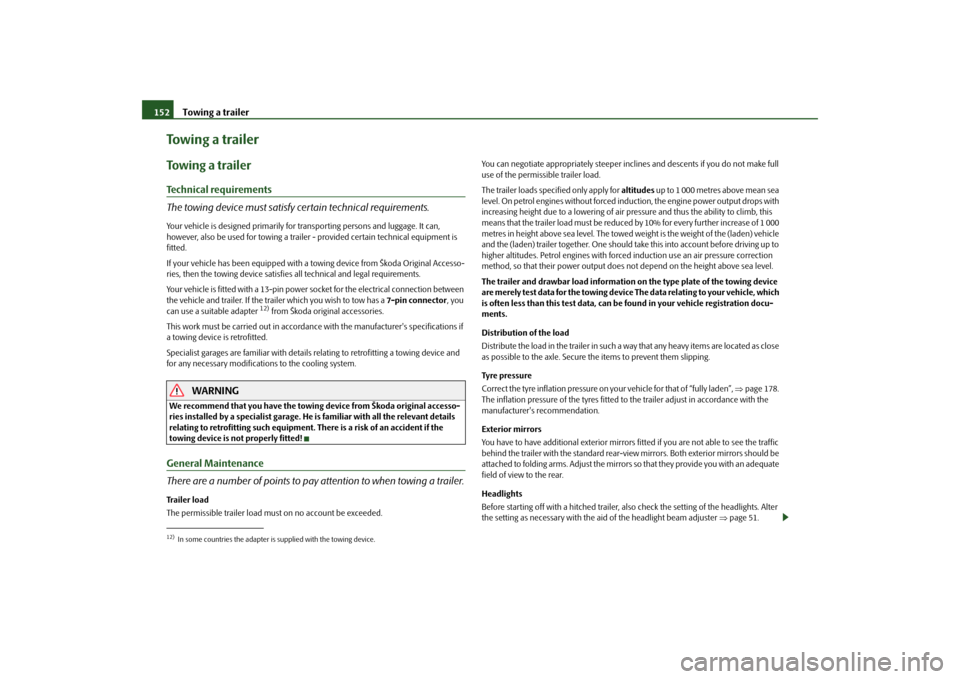
Towing a trailer
152
Towing a trailerTo w i n g a t r a i l e rTechnical requirements The towing device must satisfy certain technical requirements.Your vehicle is designed primarily for tr
ansporting persons and luggage. It can,
however, also be used for towing a traile
r - provided certain technical equipment is
fitted. If your vehicle has been eq
uipped with a towing device
from Škoda Original Accesso-
ries, then the towing device satisfies all technical and legal requirements. Your vehicle is fitted with a 13-pin power so
cket for the electrical connection between
the vehicle and trailer. If the tr
ailer which you wish to tow has a
7-pin connector
, you
can use a suitable adapter
12) from Škoda original accessories.
This work must be carried out in accordance
with the manufacturer's specifications if
a towing device is retrofitted. Specialist garages are familiar with details re
lating to retrofitting a towing device and
for any necessary modifications to the cooling system.
WARNING
We recommend that you have the towing device from Škoda original accesso-ries installed by a specialist garage. He
is familiar with all the relevant details
relating to retrofitting such equipment. There is a risk of an accident if the towing device is not properly fitted!General Maintenance There are a number of points to pay attention to when towing a trailer.Trailer load The permissible trailer load must
on no account be exceeded.
You can negotiate appropriately steeper inclin
es and descents if you do not make full
use of the permissible trailer load. The trailer loads specified only apply for
altitudes
up to 1 000 metres above mean sea
level. On petrol engines without forced indu
ction, the engine power output drops with
increasing height due to a lowering of air pr
essure and thus the ability to climb, this
means that the trailer load must be reduced by 10% for every further increase of 1 000 metres in height above sea le
vel. The towed weight is the weight of the (laden) vehicle
and the (laden) trailer together. One should ta
ke this into account before driving up to
higher altitudes. Petrol engines with forced induction use an air pressure correction method, so that their power output does
not depend on the he
ight above sea level.
The trailer and drawbar load information on the type plate of the towing device are merely test data for the towing device
The data relating to your vehicle, which
is often less than this test data, can be found in your vehicle registration docu- ments. Distribution of the load Distribute the load in the trailer in such a
way that any heavy items are located as close
as possible to the axle. Secure th
e items to preven
t them slipping.
Tyre pressure Correct the tyre inflation pressure on yo
ur vehicle for that of “fully laden”,
page 178.
The inflation pressure of the tyres fitted to
the trailer adjust in accordance with the
manufacturer's recommendation. Exterior mirrors You have to have additional ex
terior mirrors fitted if you are not able to see the traffic
behind the trailer with the standard rear-view mirrors. Both exterior mirrors should be attached to folding arms. Adjust the mirrors so that they provide you with an adequate field of view to the rear. Headlights Before starting off with a hitched trailer, al
so check the setting of the headlights. Alter
the setting as necessary with the aid of the headlight beam adjuster
page 51.
12)In some countries the adapter is supplied with the towing device.s3j8.a.book Page 152 Tuesday, April 20, 2010 1:10 PM
Page 158 of 244
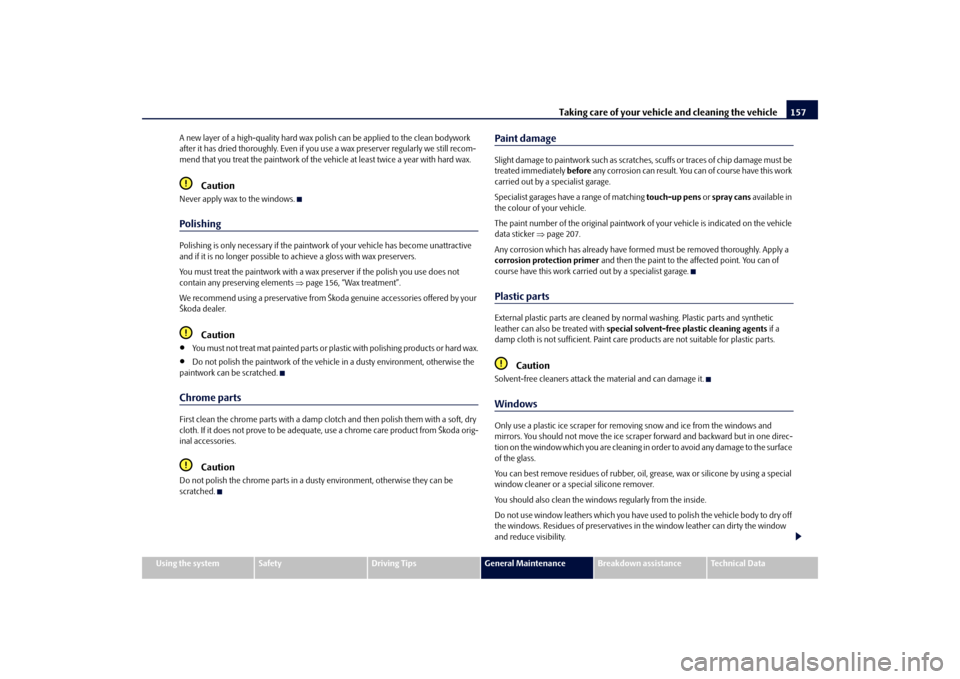
Taking care of your vehicle and cleaning the vehicle
157
Using the system
Safety
Driving Tips
General Maintenance
Breakdown assistance
Technical Data
A new layer of a high-quality
hard wax polish can be applied to the clean bodywork
after it has dried thoroughly. Even if you use a wax preserver regularly we still recom- mend that you treat the paintwork of the ve
hicle at least twice a year with hard wax.
Caution
Never apply wax to the windows.PolishingPolishing is only necessary if the paintwor
k of your vehicle has become unattractive
and if it is no longer possible to
achieve a gloss with wax preservers.
You must treat the paintwork with a wax pr
eserver if the polish you use does not
contain any preserving elements
page 156, “Wax treatment”.
We recommend using a preserva
tive from Škoda genuine accessories offered by your
Škoda dealer.
Caution
You must not treat mat painted parts or plas
tic with polishing products or hard wax.
Do not polish the paintwork of the vehicl
e in a dusty environment, otherwise the
paintwork can be scratched.Chrome partsFirst clean the chrome parts with a damp clot
ch and then polish them with a soft, dry
cloth. If it does not prove
to be adequate, use a chrome
care product from Škoda orig-
inal accessories.
Caution
Do not polish the chrome parts in a du
sty environment, otherwise they can be
scratched.
Paint damageSlight damage to paintwork such as scratches, scuffs or traces of chip damage must be treated immediately
before
any corrosion can result. You ca
n of course have this work
carried out by a specialist garage. Specialist garages have a range of matching
touch-up pens
or spray cans
available in
the colour of your vehicle. The paint number of the original paintwork of
your vehicle is indi
cated on the vehicle
data sticker
page 207.
Any corrosion which has already have formed must be removed thoroughly. Apply a corrosion protection primer
and then the paint to the affected point. You can of
course have this work carried
out by a specialist garage.
Plastic partsExternal plastic parts are cleaned by norm
al washing. Plastic parts and synthetic
leather can also be treated with
special solvent-free plastic cleaning agents
if a
damp cloth is not sufficient. Paint care pr
oducts are not suitable for plastic parts.
Caution
Solvent-free cleaners attack th
e material and can damage it.
WindowsOnly use a plastic ice scra
per for removing snow and ice from the windows and
mirrors. You should not move the ice scraper forward and backward but in one direc-tion on the window which you
are cleaning in order to avoid any damage to the surface
of the glass. You can best remove residues of rubber, oil,
grease, wax or silicone by using a special
window cleaner or a special silicone remover. You should also clean the windows regularly from the inside.Do not use window leathers which you have us
ed to polish the vehicle body to dry off
the windows. Residues of preservatives in the window leather can dirty the window and reduce visibility.
s3j8.a.book Page 157 Tuesday, April 20, 2010 1:10 PM